Disassembly Investigation of Batteries and Capacitors,
Investigation for Deterioration and Defect,
and Structural Analysis
Analysis of Negative Electrodes
In-page menu
With our low-damage cross-section creating technologies such as cooled ion milling (cryo-CP) in a non-exposure manner and electron energy loss spectrum (EELS) nano-region mapping technology using an aberration-corrected scanning transmission electron microscope (Cs-STEM), JFE-TEC can analyze the coating (SEI) of the negative electrode surface such as carbon and silicon (Si).
List of Analysis Methods
| Analysis method | Non-exposure | Option | |
|---|---|---|---|
| Processing method | Ion milling method | ○ | Cooling |
| Focused ion beam (FIB) method | Cooling | ||
| Surface (cross-section) analysis | SEM | ○ | Energy dispersive X-ray analysis (EDX) Secondary electron image/backscattered electron image Electron back scattering diffraction (EBSD) method In-situ (all-solid battery) |
| TEM | ○ | Spherical aberration (Cs) correction, Scanning transmission electron microscope (STEM) Energy dispersive X-ray analysis (EDX) Electron energy loss spectrum (EELS) Selected area diffraction Ultra-low acceleration voltage |
|
| Energy dispersive X-ray analysis (EDX) | |||
| Photoelectron spectroscopy (XPS) | |||
| Auger electron spectroscopy (AES) | ○ | ||
| Glow discharge optical emission spectrometry (GD-OES) | ○ | ||
| Composition analysis | Inductively coupled plasma (ICP) | ICP - emission spectroscopy (AES) ICP - mass spectrometry (MS) |
|
| Solid NMR | ○ | 7Li, 13C | |
| Structural analysis | X-ray diffraction (XRD) | ○ | In-situ analysis |
| Moisture analysis | Karl Fischer method | ○ | |
| Analysis method | Application | |
|---|---|---|
| Binder analysis | Thermogravimetric analysis (TGA) | PVDF |
| GC-MS | ||
| Gel permeation chromatograph (GPC) | ||
Structural Analysis of a Carbon-based Negative Electrode
Carbon-based active material, which is commonly used for lithium (Li)-ion batteries, is divided into various types including natural graphite, artificial graphite, meso-carbon micro-beads (MCMB), and non-graphitizable carbon.
Example of cross-sectional FE-SEM observation without exposure to atmosphere
(negative electrode material for batteries)
-
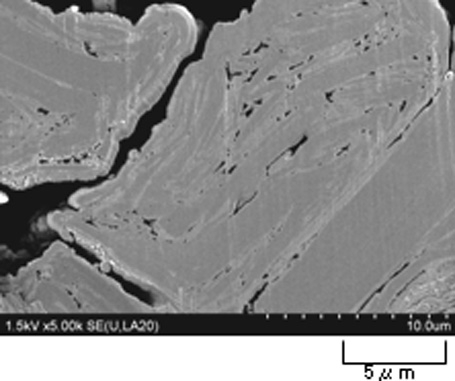
Photo 1: FE-SEM image after cross-
sectional iron milling
without exposure to atmosphere -
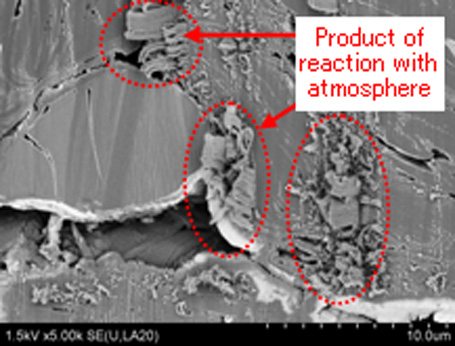
Photo 2: Result of observation of
processing with the conventional method - by - productsable is
deposited through reaction of material with atmosphere
| New battery | Deteriorated battery |
|---|---|
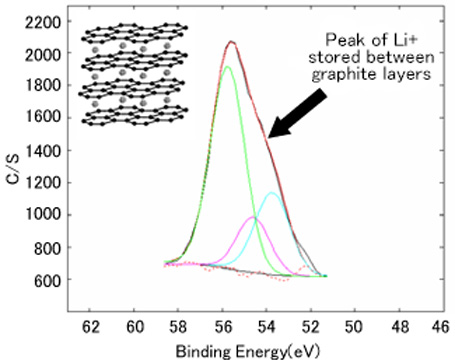 |
 |
Fig. 3: Case example of analysis of the Li state on the carbon negative electrode surface of a deteriorated battery (XPS)
New battery → Li+ ions are stored between graphite layers
Deteriorated battery → metallic Li is deposited on the electrode surface
We conduct comprehensive assessment of surface functional group analysis of functional carbon for battery materials.
-
Characteristics of the functional carbon
Carbon materials, which have diversified structures, are used in a broad range of applications such as negative electrodes of lithium-ion secondary batteries, electrodes and separators of fuel cells, and electrodes for capacitors.
The characteristics of carbon can be analyzed and evaluated from various viewpoints. This section introduces analyses of surface functional groups, which are considered to affect electric characteristics (electric capacity, electric resistance) as well as the battery life.
-
Analysis method
We comprehensively evaluate the characteristics of carbon based on the difference in the content of surface functional groups by conducting multilateral measurements and analyses such as chemical analysis, physical structure analysis and organic structure analysis.
・ Acid-base titration method: Boehm method
・ Semiquantitative method based on XPS
・ Semiquantitative method based on FT-IR
In addition to these, we also recommend using our analyses such as an iodine and methylene blue adsorption performance evaluation as an evaluation of the pore structure of carbon material, which is said to contribute to electric capacity and responsiveness.
Case example of analysis (acid-base titration method: analysis of the carbon surface functional group based on the Boehm method)
Perform back titration using a hydrochloric acid solution with an "automatic potentiometric titrator" by individually adding sodium hydroxide and sodium hydrogen carbonate to the sample (in inert atmosphere).
- Total content of acidic functional groups (total acid content): hydrochloric acid solution consumption under conditions where sodium hydroxide is added
- Content of strongly acidic functional groups (carboxyl group content): hydrochloric acid solution consumption under conditions where sodium hydrogen carbonate is added
- Content of weakly acidic functional groups (phenolic hydroxyl group content): total acid content - carboxyl group content
-
⇒ Measurement of the content of surface functional groups of carbon material not only enables you to grasp the characteristics of the carbon material as functional material, but also is effective for product management in the manufacturing process.
An example of
measurement (Table 1)
Improved carbon B and C are considered to have greater total acid content and higher electric reactivity than conventional carbon A. -
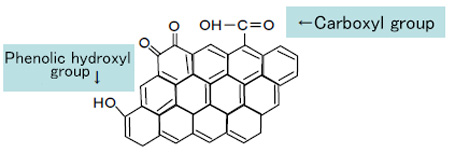
Representative surface functional groups of carbon
| Sample | Total acid content [ mmol/g ] |
Phenolic hydroxyl group [ mmol/g ] |
Carboxyl group [ mmol/g ] |
|---|---|---|---|
| A: Conventional carbon | 0.18 | 0.17 | 0.01 |
| B: Improved carbon | 0.44 | 0.34 | 0.10 |
| C: Improved carbon | 0.52 | 0.40 | 0.12 |
Structure Analysis of the Silicon (Si) Negative Electrode
We can track how the negative electrode material changes in the charge-discharge process by combining various analysis methods.
The following introduces examples of negative electrodes using single-crystal Si as the active material.
In-situ crystal structure analysis during charge and discharge
-
Change in crystalline state where Li is being stored can be captured by repeatedly performing XRD measurement while charging with a half-cell structure of a Li counter electrode.
Since the (111) peak of the single crystal Si is decreased as the charge progresses, decrease in crystallinity associated with charge was confirmed.
-
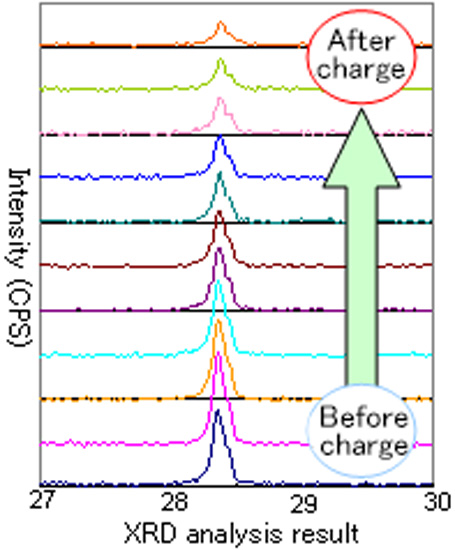
Behavior of Li in a Si negative electrode in state of charge
As a result of performing SEM observation and TEM observation with a 40% charged Si negative electrode not exposed to atmosphere, a meshed affected zone (non-crystalline) was observed in the active material.
By conducting EELS analysis, it was found that the affected zone was a layer formed through Li-Si reaction.
In addition, we can also examine the relationship between entry direction of Li and the crystal orientation of Si using EBSD and analyze the compositions of SEI based on the STEM-EELS method.
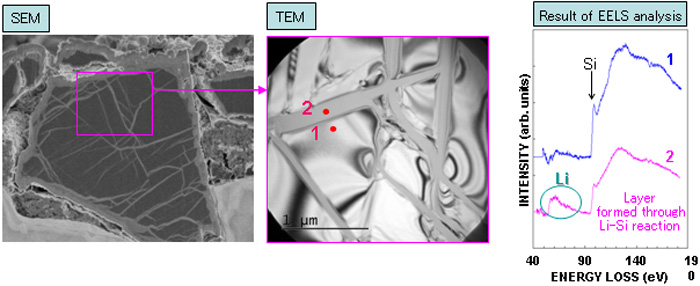
Analysis of the Li Insertion Direction in the Si Negative Electrode using the Electron Back Scattering Diffraction Method
The Si negative electrode is a negative electrode material that stores Li through insertion of Li into Si.
The following SEM image was obtained as a result of observing how Li was inserted by charging single-crystal Si with 40% charged while using the single-crystal Si as the negative electrode.
The meshed structure appearing in the active material is a region that was non-crystallized through insertion of Li.
As a result of analyzing the EBSD measurement result, it was found that the measuring plane was the (001) plane, and the Li insertion path coincided with the (101) plane of Si.
This result suggests that Li was selectively inserted along the (101) plane of Si during charge.



